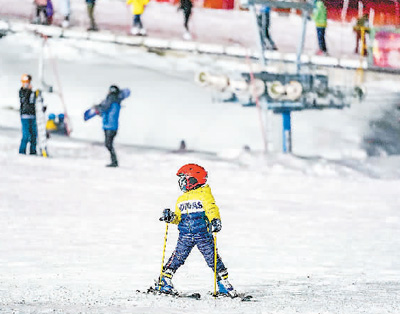


A boy skis in a ski resort in Urumqi in Xinjiang Uygur Automous Region. (Photo/Xinhua)
Physical exercise and sports-themed travels are becoming new routine activities for more and more Chinese people during the Spring Festival, as the consciousness of fitness and health are growing rapidly nationwide as well.
Instead of staying at home, spending most of the time eating, drinking, and sleeping like many people have done during the Spring Festival in the past, an increasing number of Chinese choose to enjoy exercise during the Spring Festival holiday.
Statistics from WeRun, a function of China’s leading messaging and social media platform WeChat, which can record a user’s daily step count, revealed that from Feb.5 to 9, WeRun users were recorded a total step number of 9.63 trillion, 50 percent more than which recorded in the same period of last year.
In addition, over 130 million WeRun users were recorded a daily step count of more than 10,000 during Feb.5 to 9 this year, according to data from WeRun.
“In the past, we would spend most of the Spring Festival holiday eating and drinking with families and friends, while today, I prefer to enjoy the festival by doing some physical exercise with like-minded friends,” said a running enthusiast in Beijing, disclosing that she has less and less drinks during Spring Festival since she fell in love with running.
Snow and ice sports is the most popular one among all ways of physical exercise during the Spring Festival holiday in China. More people have flocked to various ice and snow sports grounds all over the country.
A number of parks including Olympic Forest Park and Chaoyang Park in Beijing have held a variety of ice and snow sports during this Spring Festival, besides, with the popularity of snow and ice sports across the country, plus that it snowed in many cities in south China this year, skating and skiing have also become necessities during Spring Festival holiday for people in south China.
On Feb.6, the second day of Spring Festival holiday, many children enjoyed skating in the indoor rink of a large shopping mall in Qingdao, east China’s Shandong Province, being accompanied by their parents and coaches.
“I’ve been a fan of skating since I was little, but we didn’t have many ice rinks like this one. Now we are seeing more and more people enjoying snow and ice sports, and I want my son to develop an interest in the sports,” said Xu Yuan, a mother of a 9-year-old boy.
During this Spring Festival, many people were attracted to an outdoor ice rink in east China’s Shanghai. Covering an area of about 600 square meters, the ice rink has helped citizens understand sport events of the Winter Olympics better by holding an ice sports-themed carnival, offering people direct experience of winter sports by organizing many parent-child activities and professional performances of Winter Olympics events like figure skating, ice hockey, and ice dancing.
With a rate of increase above 27 percent year-on-year, China’s snow and ice-themed tourism market has witnessed a growth rate much higher than the average growth rate of China’s tourism industry since 2015 when the country succeeded in bidding for the 2022 Winter Olympics.
Snow and ice-themed travels are popular among Chinese people during this year’s Spring Festival holiday, according to a report released by famous map app Amap, which indicated that the number of travels to ski resorts in China had risen rapidly from Feb.6 and peaked on Feb.8, and that the fever had continued until Feb.10, when the Spring Festival holiday of most people came to an end.
Hou Feng, a man who has a white-collar job in south China’s Guangdong Province, set out on his journey to Yabuli, the famous ski resort in Harbin, capital of northeast China’s Heilongjiang Province, with his parents.
“I heard that Yabuli has beautiful scenery and a variety of snow and ice sports, and that it is a good place for family travel,” expressed Hou, adding that the travel is a healthy present for his parents since they can not only go sightseeing but also enjoy sports in Yabuli.
 Fire brigade in Shanghai holds group wedding
Fire brigade in Shanghai holds group wedding Tourists enjoy ice sculptures in Datan Town, north China
Tourists enjoy ice sculptures in Datan Town, north China Sunset scenery of Dayan Pagoda in Xi'an
Sunset scenery of Dayan Pagoda in Xi'an Tourists have fun at scenic spot in Nanlong Town, NW China
Tourists have fun at scenic spot in Nanlong Town, NW China Harbin attracts tourists by making best use of ice in winter
Harbin attracts tourists by making best use of ice in winter In pics: FIS Alpine Ski Women's World Cup Slalom
In pics: FIS Alpine Ski Women's World Cup Slalom Black-necked cranes rest at reservoir in Lhunzhub County, Lhasa
Black-necked cranes rest at reservoir in Lhunzhub County, Lhasa China's FAST telescope will be available to foreign scientists in April
China's FAST telescope will be available to foreign scientists in April "She power" plays indispensable role in poverty alleviation
"She power" plays indispensable role in poverty alleviation Top 10 world news events of People's Daily in 2020
Top 10 world news events of People's Daily in 2020 Top 10 China news events of People's Daily in 2020
Top 10 China news events of People's Daily in 2020 Top 10 media buzzwords of 2020
Top 10 media buzzwords of 2020 Year-ender:10 major tourism stories of 2020
Year-ender:10 major tourism stories of 2020 No interference in Venezuelan issues
No interference in Venezuelan issues
 Biz prepares for trade spat
Biz prepares for trade spat
 Broadcasting Continent
Broadcasting Continent Australia wins Chinese CEOs as US loses
Australia wins Chinese CEOs as US loses